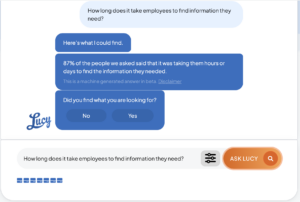Everybody loves Lucy – now with generative AI

Since ChatGPT erupted onto the scene and blew the world’s mind with the power of what could be delivered through generative AI, it’s become not only the topic of every second conversation in the tech world, but the plaything of every civilian with a net connection and an overweaned sense of trust. But did you know that AI tools have been helping out enterprises and their staff for years? Or that as of January this year, at least one has added generative AI capabilities to its make-up?
Didn’t think so.
They are, and one has been. It’s called Lucy.
We sat down with Steve Frederickson, Director of Product Management at Lucy, to talk about how generative AI within a company’s network of information points can cut down wasted search time exponentially. While the world wakes up to the power of generative AI, Lucy’s already out there, putting it to use in the business world.
But the fundamental question is why? We asked Steve what the business rationale of AI for businesses was.
SF:
One of the main reasons is the existence of unstructured data. I saw one of your earlier interviews about unlocking all of that content that exists across the enterprise, and all that knowledge that is outside of a database or a Google search or a format that is easily indexed. We use AI as a tool to interrogate that unstructured data, as well as the structured stuff, to solve problems for people.
We want to save people time, unlock knowledge that they didn’t know existed, and help people start conversations. When we do that, we approach it from a holistic viewpoint. It’s not just inputting a question and getting a list of blue links. We want to get people more than that, get them deeper, get them closer to the answer that helps them get on with their day.
Beyond the blue link.
But we also believe in something that’s more than that. Something that’s deeper, gets you closer to the answer. And something that helps you understand the journey of “What do I do once I’ve found the answer?” We can help you take the next steps. Maybe you want to grab a snippet and put it in a slide. Maybe you want to start a conversation that helps you along that journey. One of the core elements that we think about is saving people time. But we also understand that there’s so much data that exists within these big enterprises that lays dormant, so the value proposition is also about increasing the utilization and ROI of that data that exists already. That’s incredibly valuable for big enterprises.
So you have the classic use case where people come and go in a company, and nobody knows who knows what. Maybe you’re going through some new hires, and you want to get them onboarded. Maybe you want to activate some knowledge that somebody has spent a lot of time on, but it isn’t necessarily their current project, so they’re not actively promoting it. And one of the things that we hear from our customers is “How do we break down silos between departments and across organizations?”

Lucy takes you beyond the blue link of traditional search engines.
Saving time is saving money.
These big companies have institutions within their institution. And Lucy’s an easy tool for starting those conversations across groups, and really getting the most out of the knowledge that exists within the enterprise.
And then, last but not least, the time savings you can make with a business-specific AI are incredible. New hires sometimes need to know things, so they ask people, but they may not know exactly what they need to know. That means they ask people either what they need to know, or who can tell them what it is they need to know, before they even begin to contemplate getting hold of the information itself that answers their questions.
This can go on for days of lost productivity while they get their feet under them, especially if what they really need to know is something that is buried deep in the company’s unstructured data, if it’s locked up in some SharePoint somewhere or some other third party tool or application. Unless you know both a) specifically what you’re looking for, b) where it is, c) how to access it, and/or d) who can give you the answers to a, b, or c, you’re on a wild goose chase.
THQ:
And the goose is invisible and a master of disguise.
SF:
Exactly! So you get these chains of questions, as people ask each other how they get closer to the information they need, and suddenly they’re involving multiple people in that search journey.
Lucy, and AIs like Lucy, can cut all that out. Can give your subject matter experts their days back and stop new hires feeling wrong-footed and like they’re informational klutzes. It’s a real unlocking technology for people if you can just ask Lucy for the Thing You Need, or even References To The Thing You Need – it’ll get you there in seconds, rather than days of chasing that invisible, camo-covered goose.
35 minutes per question.
THQ:
What kind of data do we have that justifies these claims of days lost in productivity just from asking questions or trying to find the exact right information we need in a big company?
SF:
According to our customers’ own studies, run independently of us, they’re saving 35 minutes on average per answer found. But that can be 35 minutes to find the person to ask, 35 minutes for them to find the right silo, another 35 to find the right program, 35 to find the right year, another to find the right month, and so on. Getting the answers to the actual question asked can take multiple queries of multiple people and systems, so they build up.
Whereas with Lucy’s AI, trained to focus on the company’s data points across both structured and unstructured data, one query can take you if not directly to the part of a document, a SharePoint, a Teams meeting that you actually need to get your answer and get on with your day, then at least significantly closer than, for instance, a company-wide Google-equivalent search would get you, let alone the process of interrogating people and systems.
That means AI can give you an incredible ROI. And we’ve just added the generative AI element, which we call Lucy Synopsis. That not only does all that searching but gives you context to your search journey, too. It’ll give you a handful of potentially useful additional sources based on your search. So not only will the AI get you at least close to where you need to be in a heartbeat, but the generative AI element will show you more useful things that give your search an extra data-richness
A matter of trust.
THQ:
What’s the trust factor like? We’ve heard that, for instance, ChatGPT is great at sounding right, but can actually be just persuasively wrong. When people get results from Lucy, do they trust the answers they get – or are they then having to ask a human anyway, to check the veracity?
SF:
That’s a thing that’s at the very top of the mind for everyone as we explore some of the boundaries of ChatGPT. What are the pros and cons of generative AI? I mean, generative AI is this incredible tool. I view it as a disruptive technology to Google, right?
THQ:
So does Google. Allegedly.
SF:
Ha. Yeah. With generative AI, you can complete an entire journey without clicking on a blue link, or, more importantly, clicking on an ad.
Confidently wrong.
As you say, one of the really core limitations that people have identified with generative AI is that it can be confidently wrong about things. And it’s very convincing. It’s a great storyteller.
It doesn’t cite its sources, it’s just saying stuff. And then there’s the question of how we show people this is an answer from a generative AI? How to be transparent about that sort of thing. And so when we think about Lucy Synopsis, which is just the starting point of generative AI at Lucy, we want to address all of those key pain points of what the AI is and what it isn’t. And we want to be very transparent, that this AI is here to help people, not replace them.
So every AI answer is tagged, “This answer is machine-generated.” But also at the same time, we built an experience that supplements the generative AI with the real search results, the answers from within your organization.
Lucy’s here to get you to the answer you need. But we believe in more than the blue link, we want to get you to the page of the document, the minute of the video, the dashboard you’re looking for. And specifically in that workflow, we want to gets you closer to that content that’s going to answer your question and let you get on with your day.
In Part 2 of this article, we’ll dive deeper into the potential of generative AI within a strictly company universe.










